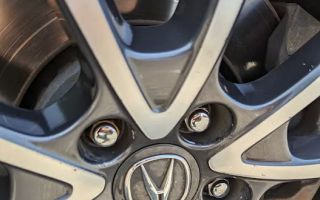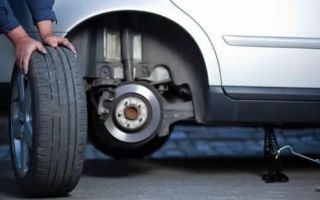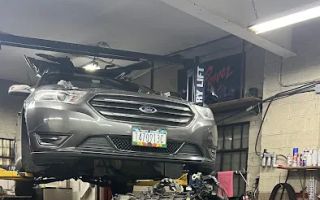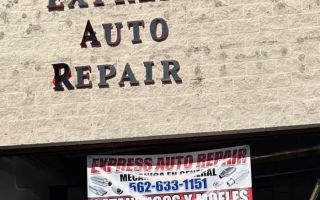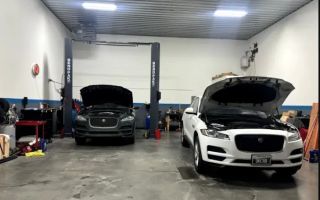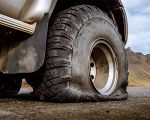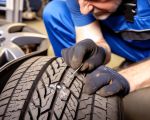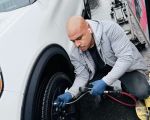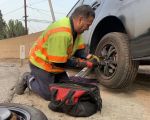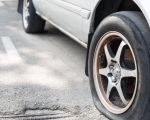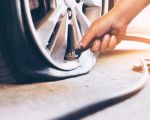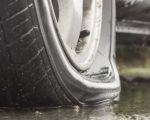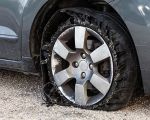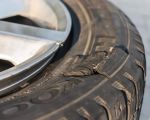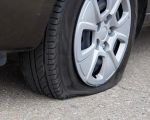How to Check Tire Pressure to Avoid a Flat Tire
Keeping your tires in optimal condition is crucial for your safety, comfort, and vehicle performance. I’ve always found that regularly checking the tire pressure is one of the easiest yet most essential maintenance tasks I can do. It’s a quick and simple process, but it can prevent frustrating flat tires and ensure a smooth ride. Over time, I’ve learned that tire pressure isn’t just about convenience – it’s about preventing problems down the road and saving myself from unexpected headaches.
Flat tires can be caused by a number of factors, but the leading cause is often low tire pressure. When the air in your tires is too low, the tire becomes more prone to damage and can even fail unexpectedly. Keeping the right amount of air in your tires is key to avoiding this scenario. Here, I’ll walk you through the process of checking your tire pressure so you can keep your car safe and running efficiently.

MR. TIRE INC.
2078 New York Ave, Huntington Station, NY 11746, USA
1. Understanding Tire Pressure and Its Importance
Before diving into how to check your tire pressure, it’s important to understand why it matters so much. Tire pressure is the amount of air inside the tire, measured in pounds per square inch (PSI). Each vehicle has a manufacturer-recommended tire pressure that’s ideal for its design and safety. This pressure ensures that your tires have enough grip on the road, wear evenly, and perform optimally. Under-inflated tires can cause your vehicle to consume more fuel, affect handling, and, worst of all, increase the risk of a flat tire or blowout.
If your tire pressure is too low, the tire has less air cushioning, and its contact with the road increases, causing more wear and tear. Too much pressure, on the other hand, can make the tire stiff, leading to reduced traction, uneven wear, and a higher risk of damage. That’s why it’s essential to maintain the recommended tire pressure for your vehicle, which is often found on a sticker inside the driver’s side door or in your vehicle’s manual.

MR. TIRE INC.
2078 New York Ave, Huntington Station, NY 11746, USA
2. Tools You Need to Check Tire Pressure
To check your tire pressure, you’ll need a few basic tools. The most important tool is a tire pressure gauge. These gauges come in several types, including digital, dial, and pen-style gauges. I’ve used all of them, and each one works well, so it’s really a matter of personal preference. Here’s what you’ll need:
- Tire pressure gauge: This tool will measure the PSI in your tires, letting you know if they’re inflated to the proper level.
- Air compressor (if necessary): If your tire pressure is low, you’ll need an air compressor to inflate it. Many gas stations have air pumps available for use.
- Vehicle owner’s manual: This will give you the recommended PSI for your vehicle. You can also find the PSI on a label inside the driver’s side door frame or in the glove box.
Now that you have the necessary tools, let’s dive into how to check your tire pressure properly.
3. Steps to Check Tire Pressure
Here’s how I check my tire pressure regularly. It only takes a few minutes and gives me peace of mind knowing that my tires are safe and in good condition.
Step 1: Ensure Your Tires Are Cold
It’s always best to check your tire pressure when your tires are cold. This means the car has been sitting for at least three hours or hasn’t been driven for more than a couple of miles. If you check tire pressure right after driving, the heat generated from driving can give you inaccurate readings because the air inside the tire expands when it’s heated.
Step 2: Locate the Valve Stem
The valve stem is the small rubber or metal stem that sticks out from each tire. It’s where you’ll attach the tire pressure gauge. I always ensure the valve stem is free of dirt or debris before attaching the gauge to avoid any issues.
Step 3: Use the Tire Pressure Gauge
Once you’ve located the valve stem, take your tire pressure gauge and press it firmly onto the valve stem. If you're using a digital gauge, you'll see the PSI reading immediately. For dial gauges, the needle will move to indicate the pressure, while pen-style gauges will pop out a small stick to show the PSI. I always make sure to press firmly so that no air escapes and I get an accurate reading.
Step 4: Read the PSI
Once the gauge is in place, you’ll see the PSI reading on the display. Compare this to the recommended PSI for your vehicle, which you should have from your vehicle’s manual or the door frame label. If the PSI is lower than the recommended number, it’s time to add air to your tire. If it’s too high, you can release some air until it reaches the right level.
Step 5: Inflate or Deflate as Needed
If the tire pressure is too low, use an air compressor to inflate it to the correct PSI. Many gas stations have air pumps available for public use. Make sure to go slowly and check the pressure frequently to avoid over-inflating the tire. If the pressure is too high, use the small valve on the valve stem to release some air until you reach the ideal PSI.
Step 6: Recheck the Pressure
Once you’ve adjusted the tire pressure, it’s a good idea to check it again. Sometimes a little air can escape while you’re inflating or deflating, so it’s always a good practice to make sure the reading is exactly what it should be. If everything is correct, you’re done!
4. How Often Should You Check Your Tire Pressure?
It’s recommended to check your tire pressure at least once a month, but I personally like to do it more often. If you're planning a long road trip or notice that your tires seem to be losing air, make sure to check them before you hit the road. Additionally, tire pressure tends to drop during colder weather, so it's essential to check it more frequently during winter.
5. Common Tire Pressure Issues and How to Address Them
Over time, tires naturally lose air, and I’ve had to deal with a few common tire pressure issues. Here are some of the problems I’ve encountered and how to handle them:
Low Tire Pressure
If you notice that one or more of your tires has low pressure, it could be due to a slow air leak or simply natural air loss over time. If it’s a slow leak, you might need a tire repair. I’ve had to take a tire to a shop for a patch before, which is usually a quick and affordable fix.
High Tire Pressure
If your tire pressure is too high, this can lead to a rough ride, poor traction, and a higher risk of a blowout. I’ve experienced this before after over-inflating, so I always double-check the pressure and release some air if necessary.
Uneven Tire Pressure
If one tire is significantly lower than the others, it could indicate a puncture or a slow leak. If the difference in pressure is noticeable, I usually take the car to a professional to check for any leaks or damage that could require repair.
6. Conclusion
Maintaining the proper tire pressure is one of the easiest yet most effective ways to prevent flat tires and extend the life of your tires. By regularly checking the pressure, you can ensure that your vehicle is running at its best. Remember, tire pressure plays a significant role in your safety on the road, so take the time to check it often and keep your car in top condition.
If you ever find yourself in need of roadside assistance or a tire repair service, I recommend checking with local service providers for fast and reliable help. It’s always better to be prepared and know who to call in case of an emergency.




